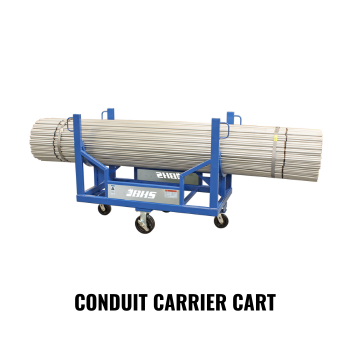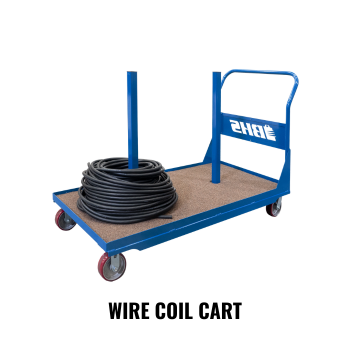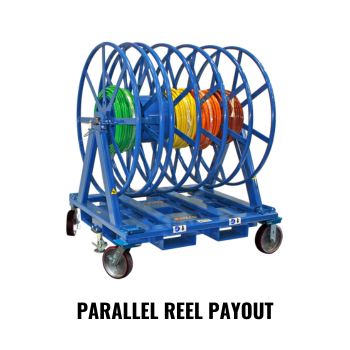We use cookies to make your experience better. To comply with the new e-Privacy directive, we need to ask for your consent to set the cookies. Learn more.
Handling ENT Conduit From Warehouse to Jobsite
Electrical nonmetallic tubing — ENT — is a popular conduit choice for low-voltage wiring raceways in homes, commercial buildings, offices, and more. Compared to rigid metallic conduit, ENT offers electricians a few distinct advantages:

- Because it’s flexible, ENT eliminates time-consuming bends required by rigid conduit.
- Most ENT currently on the market is concrete-tight, so it’s suitable for use in poured concrete floors and walls.
- Thin PVC construction doesn’t create sharp edges when you cut it. That makes it generally safer for installers than metallic conduits.
- ENT is extremely lightweight, so it’s easy to handle during installations.
In short, ENT offers a convenient raceway system for data cable, alarm systems, and branch wiring, including concrete-encased runs. Given these common use cases, demand for ENT is high. That means both electrical wholesalers and electrical contractors should get used to working with this material.
However, unlike rigid conduit, which tends to ship in standard lengths, manufacturers offer ENT in a number of packages. Wholesalers may sell these products just as they ship from the manufacturer, or they might repackage them into ready-to-use solutions. Electricians will have the choice of multiple packaging types from the wholesaler.
That complexity makes it hard to choose the best material handling strategy for ENT — and appropriate material handling is essential for maximizing productivity. Construction electricians spend up to 40 percent of their time on-shift just handling materials. In other words, material handling is the single biggest productivity drain for many electrical firms.
With the right material handling strategy — and the equipment to put your plan into action — electricians can reduce material handling time significantly. They can complete installations faster and with less risk of injury. Meanwhile, wholesalers can speed up shipments, boost throughput, and ensure customer loyalty.
Here’s what electrical industry professionals across the supply chain need to know about material handling for ENT.
The Three Ways Manufacturers Package ENT
The best material handling strategy always depends on how materials are packaged. For example, forklifts are ideal for working with palletized loads, but they’re rarely helpful for bagged materials. When handling large amounts of ENT, then, you need a different approach for differently organized shipments. Manufacturers generally sell ENT in three forms:
- 10-foot (3.048-meter) lengths, similar to rigid PVC conduit
- Longer loose coils, typically shrink-wrapped for stability
- Bulk stock reels
Here are a few tips for handling each of these common arrangements, as safely and efficiently as possible:
Handling 10-Foot ENT Sticks
A 10-foot (3.048-meter) stick of ENT conduit can weigh as little as half a pound (0.45 kilograms). Heavy lifting isn’t the biggest ergonomic risk of handling these materials. The real challenge is moving sufficient quantities of ENT sticks without making multiple trips from storage to your destination.
The best way to reduce trips to and from storage areas is to carry sufficient quantities of materials with you as you work. For wholesalers, that may just mean loading orders onto a truck. At the jobsite, however, it means continually moving a store of ENT conduit along your installation route.
Even with a lightweight material like ENT, the solution is a cart designed specifically for conduit. Conduit Carrier Carts from Solus Group handle large bundles of conduit, including ENT sticks. With space and carrying capacity to spare, you can load a Conduit Carrier Cart with a mix of ENT and rigid PVC conduit — an ideal combination, since many raceways combine these materials.
Buy Conduit Carrier Carts from Solus Group
At the jobsite, you might run into another material handling challenge: The 10-foot (3.048-meter) length of standard ENT sticks can make it difficult to get around tight corners. It also poses a problem for small elevator carts and other narrow spaces.
If you’re working without a lot of room to spare, load your ENT and PVC sticks onto a Tilting Elevator Conduit Cart. This dedicated electrician truck features an adjustable storage bed; tilt it up to 45 degrees to limit load width/length. That way, you can carry your conduit just about anywhere.
Buy Tilting Elevator Conduit Carts from Solus Group
Handling Bulk ENT Coils
There are three major advantages to working with ENT: It’s lightweight, easy to cut, and bendable by hand. These strengths make ENT easy to work with at the point of installation, which means there’s no reason not to carry bulk runs along with you as you work. For runs that exceed 10 feet (3.048 meters), you’re better off purchasing ENT coils (or reels — but we’ll cover those in the next section). That way you can cut and bend lengths as you need them, all but eliminating trips to and from storage locations.
Again, however, the material handling challenge comes from the need to carry ENT coils with you as you go. They’re too bulky to simply hang from your belt. The simplest solution is another cart — but coils aren’t designed to sit stably on Conduit Carrier Carts or standard utility trucks.
Instead, choose a cart that’s designed to keep coiled materials stable during transit. The Wire Coil Cart from Solus Group offers more than 10 square feet (3.048 square meters) of storage for bulky ENT coils, complete with stability posts to keep your load in place. Ergonomic push bars and smooth-rolling casters simplify travel, and you might even have room to spare for tools, fittings, and accessories. That makes this product a full-service electrician cart for ENT runs.
Buy Wire Coil Carts from Solus Group
Handling ENT Stock Reels
Wholesalers can get the best prices by purchasing in bulk — and that typically means ENT shipped on stock reels. But wholesalers aren’t the only ones who benefit from reeled flexible raceway. Larger installations require more ENT; the most efficient way to keep a whole job’s worth of conduit close at hand is with a reel cart that doubles as an instant payout solution.
The Parallel Reel Payout starts with a steel A-frame stand built onto a rolling, forklift-compatible base. Then you choose an arrangement of fixed, free-spinning, or conjoined steel reels. Wholesalers can outfit a single Parallel Reel Payout for multiple ENT products, making it easier than ever to fill orders from master reels.
Because the Parallel Reel Payout doubles as a heavy-duty cart, wholesalers have more flexibility in their storage and handling systems. And on big installations, a single loaded Parallel Reel Payout offers all the ENT you need to get the job done — ready for storage, movement, and payout all at once.



